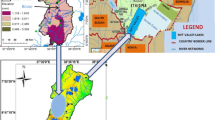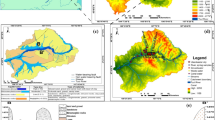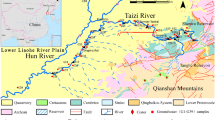Abstract
The groundwater flow system and the flow velocity in the alluvial fan plain of the Hutuo River, China, have been studied, with an emphasis on relating geochemical characteristics and isotopes factors. Seven stretches of one river, six springs and 31 wells, with depths ranging from 0 m (river waters) to 150 m, were surveyed. The groundwater has a vertical two-layer structure with a boundary at about 80–100 m depth, yielding an upper and a lower groundwater layer. The δ18O and δD values range from −10.56 to −7.05‰ and −81.83 to −59‰, respectively. The groundwater has been recharged by precipitation, and has not been subjected to significant evaporation during infiltration into the aquifer in the upper layer. Using a tritium model, the groundwater flow in the alluvial fan plain showed horizontal flow velocity to be greater than vertical velocity. Groundwater in the upper layer is characterized by Ca–HCO3 type. From the spatial distribution characteristics of the stable isotope and chemical composition of the groundwater, agricultural irrigation was considered to have an influence on the aquifer by causing excessive groundwater abstraction and irrigation return.
Résumé
Le système d’écoulement de l’eau souterraine et la vitesse d’écoulement dans le plaine du cône alluvial de la Rivière Hutuo, Chine, ont été étudiés en mettant l’accent sur les caractéristiques géochimiques et les facteurs isotopiques correspondants. Sept tronçons d’une rivière, six sources et 31 puits, ayant des profondeurs allant de 0 m (eau de la rivière) à 150 m, ont été examinés. L’eau souterraine a une structure verticale à deux couches avec une limite à environ 80–100 m de profondeur, formant une couche supérieur d’eau souterraine et une inférieure. Les valeurs de ∂ 18 O et de ∂ D vont de −10.56 à −7.05‰ et de −81.83 à −59‰, respectivement. L’eau souterraine a été réalimentée par les précipitations, et n’a pas été sujette à une évaporation significative au cours de l’infiltration dans l’aquifère de la couche supérieure. En utilisant modèle tritium, l’écoulement de l’eau souterraine dans la plaine du cône alluvial a montré une vitesse d’écoulement horizontal supérieure à la vitesse verticale. L’eau souterraine de la couche supérieure est caractérisée par un type Ca–HCO3. Du fait des caractéristiques de la distribution spatiale en isotope stable et de la composition chimique de l’eau souterraine, l’irrigation agricole a été jugée avoir une influence sur l’aquifère en occasionnant des prélèvements d’eau souterraine et une restitution provenant de l’agriculture excessifs.
Resumen
Se ha estudiado el sistema de flujo subterráneo y la velocidad de flujo en el cono aluvial del Río Hutuo, China, enfatizando las características geoquímicas y su relación con el contenido isotópico. Se relevaron siete tramos del río, seis manantiales y 31 pozos, con profundidades que varían desde 0 m (agua del río) hasta 150 m. El complejo subterráneo comprende dos capas con un límite a una profundidad aproximada de 80–100 m, constituyendo una capa subterráneas superior y una inferior. Los valores de δ18O yδD varían entre −10.56 a −7.05‰ y −81.83 a −59‰, respectivamente. El agua subterránea se recargó por lluvias, y no ha estado sujeta a evaporación durante su infiltración en la capa superior del acuífero. El modelo de flujo subterráneo, utilizando datos de tritio, mostró que la velocidad del flujo horizontal es mayor que la vertical. El agua subterránea de la capa superior es del tipo Ca–HCO3. Teniendo en cuenta la distribución espacial de los isótopos estables y la composición química del agua subterránea, se considera que el riego para agricultura ha tenido influencia en el acuífero debido al bombeo excesivo de agua y los retornos por riego.














Similar content being viewed by others
References
Andersen LJ, Sevel T (1974) Profiles in the unsaturated and saturated zones, GrØnhØj, Denmark. In: Isotope techniques in groundwater hydrology, vol I, IAEA Symposium, IAEA, Vienna, pp 3–20
Chen R (1988) Tracing water interaction by using natural isotopes. In: Liu CM, Ren HZ (eds) Air, surface, soil and groundwater interactions-experiment and calculation analysis (in Chinese). Science Press, Beijing, pp 33–50
Chen J, Tang C, Sakura Y, Kondoh A, Shen Y (2002) Groundwater flow and geochemistry in the lower reaches of the Yellow River: a case study in Shandong Province, China. Hydrogeol J 10:587–599
Chen Z, Qi J, Xu J, Xu J, Ye H, Nan Y (2003) Paleoclimatic interpretation of the past 30 ka from isotopic studies of the deep confined aquifer of the North China plain. Appl Geochem 18:997–1009
Chen J, Tang C, Sakura Y, Kondoh A, Yu J, Shimada J, Tanaka T (2004) Spatial geochemical and isotopic characteristics associated with groundwater flow in the North China Plain. Hydrol Process 18:3133–3146
Chen Z, Nie Z, Zhang Z, Qi J, Nan Y (2005) Isotopes and sustainability of ground water resources, North China Plain. Ground Water 43:485–493
Clark ID, Fritz P (1997) Environmental isotopes in hydrogeology. Lewis, Boca Raton, FL, pp 173–183
Craig H (1961) Isotopic variation in meteoric waters. Science 133:1702–1703
Craig TS, Kumar AN, Juliette AW, Andrew LH (2002) Groundwater flow and solute transport at the Mourquong saline-water disposal basin, Murray Basin, southeastern Australia. Hydrogeol J 10:278–295
Dansgaard W (1964) Stable isotopes in precipitation. Tellus 16:436–438
Freeze RA, Cherry JA (1979) Groundwater. Prentice Hall, Englewood Cliffs, NJ, 604 pp
Fritz SJ, Drimmie RJ, Fritz P (1991) Characterizing shallow aquifers using tritium and 14C: periodic sampling based on tritium half-life. Appl Gochem 6:17–33
Güler C, Thyne GD, McGray JE, Turner AK (2002) Evaluation of graphical and multivariate statistical methods for classification of water chemistry data. Hydrogeol J 10:455–474
Hill RA (1940) Geochemical patterns in Coachella Valley. Trans Am Geophys Union 21:46–49
John AI, John R, Robert LM (2002) Movement of water through the thick unsaturated zone underlying Oro Grande and Sheep Creek washes in the western Mojave Desert, USA. Hydrogeol J 10:409–427
Liu C, Wang P (1992) The environment significance of isotope composition in groundwater of Hebei Plain. In: Proceedings of International Workshop on Groundwater and Environment. Beijing, August 1992, pp 16–18
Merlivat LJ, Jouzel (1979) Global climatic interpretation of deuterium-oxygen relationship for precipitation. J Geophys Res 84:5029–5033
Ministry of Health of the People’s Republic of China (2006) Water quality standard for drinking water sources in China, Ministry of Health, Beijing
Nakayama T, Yang Y, Watanabe M, Zhang X (2006) Simulation of groundwater dynamics in the North China Plain by coupled hydrology and agricultural models. Hydrol Process 20:3441–3466
Piper AM (1944) A graphic procedure in the geochemical interpretation of water analyses. Trans Am Geophys Union 25:914–923
Shao S, Zhonggyuan A, Han S (1984) Analysis on the main characteristics of the neotectonic movement in the Hebei Plain. Mar Geol Quat Geol 4(4):67–77
Shimada J, Tang C, Iwatsuki T, Xu S, Tanaka T, Sakura Y, Song X, Yang Y (2002) Groundwater flow system of Hebei plain area and their recent groundwater environment change. In: Research Report of Water Resources Research Center No. 22. Kyoto University, Kyoto, Japan, pp 95–99
Stuyfzand PJ (1999) Patterns in groundwater chemistry resulting from groundwater flow. Hydrogeol J 7:15–27
Toth J (1999) Groundwater as a geologic agent: an overview of the causes, processes and manifestations. Hydrogeol J 7:1–14
Unterweger MP, Coursey BM, Shima FJ, Mann WB (1980) Preparation and calibration of the 1978 National Bureau of Standards tritiated water standards. Int J Appl Radiat Isot 31:611–614
Wu C (1992) The environmental evolution during the last 40 ka B.P. in North China plain. Science and Technology Press, Beijing
Wu C, Xu Q, Ma Y, Zhang X (1996a) Palaeochannels on the North China Plain: palaeoriver geomorphology. Geomorphology 18:37–45
Wu C, Xu Q, Zhang X, Ma Y (1996b) Palaeochannels on the North China Plain: types and distributions. Geomorphology 18:5–14
Xu Q, Wu C, Zhu X, Yang X (1996a) Palaeochannels on the North China Plain: stage division and palaeoenvironments. Geomorphology 18:15–25
Xu Q, Wu C, Yang X, Zhang N (1996b) Palaeochannels on the North China Plain: relationships between their development and tectonics. Geomorphology 18:27–35
Yang Y, Lin X, Elliot T, Kalin RM (2001) A natural-gradient field tracer test for evaluation of pollutant-transport parameters in a porous-medium aquifer. Hydrogeol J 99:313–320
Yang S, Li C, Cai J (2006) Geochemical compositions of core sediments in eastern China: implication for Late Cenozoic palaeoenvironmental changes. Palaeogeogr Palaeoclimatol Palaeoecol 229:287–302
Yang Y, Watanabe M, Zhang X, Zhang J, Wang Q, Hayashi S (2006) Optimizing irrigation management for wheat to reduce groundwater depletion in the piedmont region of the Taihang Mountains in the North China Plain. Agric Water Manage 82:25–44
Zhang Z, shen Z, Xue Y, Ren F, Yin Z, Zhong Z, Sun X (2000) Evolution of groundwater environment in North China Plain. Geological Publishing House, Beijing, pp 35–60
Zhou L, Liu C, Jiang S, Gao S (2001) A study of 36Cl age in Quaternary groundwater of Hebei Plain, China. Sci China (Series E) 44:11–15
Author information
Authors and Affiliations
Corresponding author
Rights and permissions
About this article
Cite this article
Lu, Y., Tang, C., Chen, J. et al. Spatial characteristics of water quality, stable isotopes and tritium associated with groundwater flow in the Hutuo River alluvial fan plain of the North China Plain. Hydrogeol J 16, 1003–1015 (2008). https://doi.org/10.1007/s10040-008-0292-3
Received:
Accepted:
Published:
Issue Date:
DOI: https://doi.org/10.1007/s10040-008-0292-3




